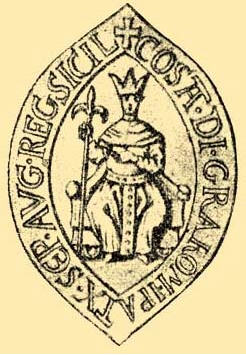Top Qs
Timeline
Chat
Perspective
Constance of Aragon, Holy Roman Empress
Holy Roman Empress from 1220 to 1222 From Wikipedia, the free encyclopedia
Remove ads
Constance of Aragon (Catalan: Constança d'Aragó, 1179 – 23 June 1222) was an Aragonese infanta who was by marriage firstly queen of Hungary and Croatia, and secondly queen of Germany and Sicily and Holy Roman empress. She was regent of Sicily from 1212 to 1220.
This article includes a list of references, related reading, or external links, but its sources remain unclear because it lacks inline citations. (June 2024) |
She was the second child and eldest daughter of the nine children of Alfonso II of Aragon and Sancha of Castile.[1]
Remove ads
Queen of Hungary
Constance's marriage to King Emeric of Hungary was credited to Emeric's stepmother, Margaret of France.[1] The wedding took place in 1196.[1] Four years later, in 1200, the queen gave birth to a son, called Ladislaus.[1]
When King Emeric was dying, he crowned his son Ladislaus co-ruler on 26 August 1204. The king wanted to secure his succession and had his brother Andrew promise to protect the child and help him govern the Kingdom of Hungary until reaching adulthood. Emeric died three months later, on 30 November.
Ladislaus succeeded him as king while Andrew became his regent. Andrew soon took over all regal authority while Ladislaus and Constance were little more than his prisoners. Constance managed to escape to Vienna with Ladislaus.[1]
The two found refuge in the court of Leopold VI, Duke of Austria, but Ladislaus died 7 May 1205.[1] The former regent and now King Andrew II of Hungary took the body of his nephew and buried him in the Royal Crypt of Székesfehérvár. Duke Leopold sent Constance back to Aragon.
Remove ads
Queen of Sicily and Holy Roman Empress
Summarize
Perspective

When Constance returned to Aragon, she took up residence with her mother, Queen Sancha, in the Abbey of Our Lady at Sijena; Sancha had founded the abbey after her husband's death, and now lived there in retirement. Constance spent the next three years in the abbey with her mother.
Peter II wanted to be on good terms with Pope Innocent III since he wanted an annulment of his marriage with Maria of Montpellier. The pope solicited Constance's hand for his pupil, the young King Frederick of Sicily. Peter accepted the proposal; Constance left her mother and began her trip to Sicily in 1208. Sancha died shortly after.
Constance and Frederick were married in the Sicilian city of Messina on 15 August 1209. In the ceremony, she was crowned queen of Sicily. Constance was 30 and her new husband 14. In 1211, Constance gave birth to a son, called Henry.
On 9 December 1212, Frederick was crowned king of Germany in opposition to Emperor Otto IV. Constance stayed in Sicily as regent until 1220.
At first Frederick controlled Southern Germany and Otto IV was effectively deposed on 5 July 1215. This time Constance was crowned German queen with her husband.
Pope Honorius III crowned Frederick Holy Roman emperor on 22 November 1220. Constance was crowned empress while their son Henry became the new king of Germany. She died of malaria less than two years later in Catania and was buried in the Cathedral of Palermo, in a Roman sarcophagus with a crown, the Crown of Constance.
Remove ads
References
Sources
Wikiwand - on
Seamless Wikipedia browsing. On steroids.
Remove ads

